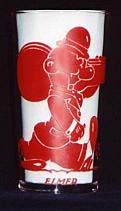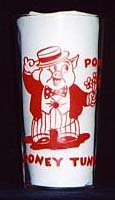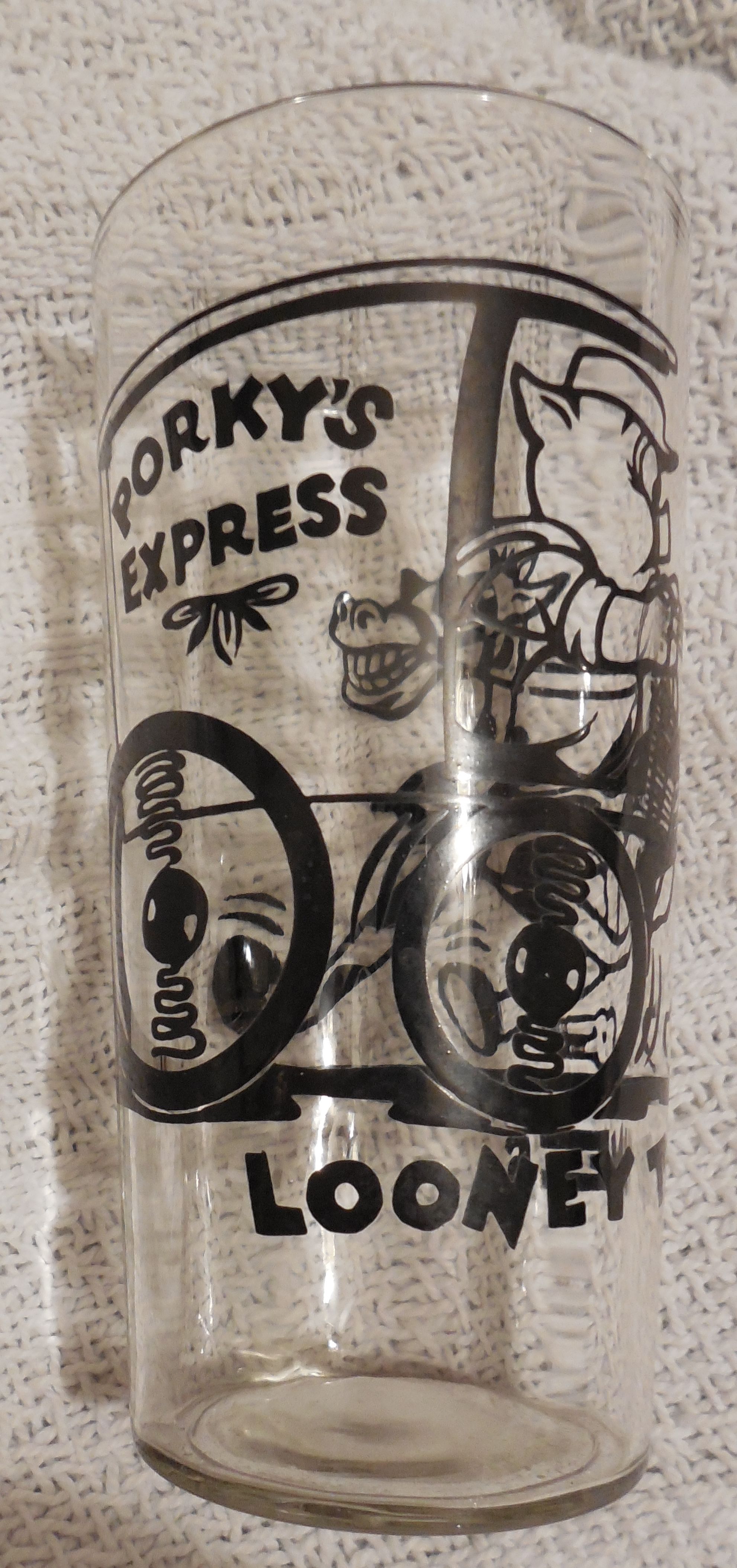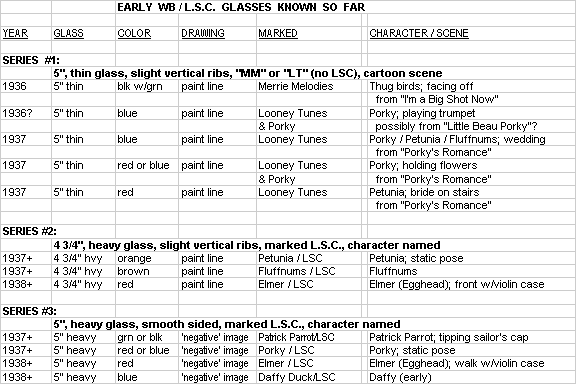Warner Bros. Glasses - The Early Years
First published in CGN #67 August/September 2001
Byline: Matt Maloney and Paul Merrole
In the history of Warner Bros. cartoon
characters on glass, two thing are clear:
1) The Pepsi
/ W.B. promotions of the 70's were hugely successful, and resulted in
the  distribution
of vast numbers of glasses. distribution
of vast numbers of glasses.
2) The earliest
promotions featuring W.B. characters in the 30's were apparently of such
small production that those glasses are among the rarest and most sought
after today.
Why is that? The answer is that the cartoon
characters from Warner Bros, who had become extremely popular by the 70's,
were virtual unknowns forty years earlier or were yet to be created. The
cartoon world of the 1930's was dominated by Walt Disney. It was with
Disney's characters who blazed the trail of cartoon characters on promotional
glassware. Since his films were the ones most widely seen and admired
at that time, his characters would have been the ones with the most promotional
value. And what a win-win situation those glasses must have been for Disney!
Food processors were paying licensing fees to use his characters on thousands
of glasses containing their products, and in doing so were greatly increasing
the visibility and value of those characters.
Enter Leon Schlesinger. Leon was a small-time
money man, business friend of the Warners, and owner of the studio that
made their cartoons. He had only entered into the cartoon production business
because he knew he could rely on the Warner brothers to distribute his
cartoon output, assuring him of making a buck. Using his studio's characters
on promotional glassware, just like Disney's, was too good an idea to
have escaped his attention. But while several of Disney's characters were
already well known by 1936, the first film starring Porky Pig, who would
develop into the Schlesinger studio's first major character, had just
been released.
So exactly what was done next? Unfortunately,
we can not say with certainty. There is no mention of these glasses in
any of the many books about the Warner Bros. studio, including those authored
by Warner Bros. employees. The good news is that enough other information
can be gathered to establish a pretty definite timeline and likely course
of events. Researching the studio's film output and the history of each
character has enabled us to date the glasses. Studying the physical details
of glasses found so far has enabled us to confirm that more than one series
of glasses exists.
THE CHARACTERS:
Just like their live-action counterparts,
a cartoon character may make an appearance in one film, then never be
seen again. If we were to find an undated promotion featuring that character
today and knew the year the film was released, we would know the year
of that promotion. So it  goes
for the glass featuring Patrick Parrot. He appeared in one cartoon, after
which the studio gave up on him and never used him again. The film, and
so likely the glass, is from 1937. goes
for the glass featuring Patrick Parrot. He appeared in one cartoon, after
which the studio gave up on him and never used him again. The film, and
so likely the glass, is from 1937.
But what if the character became a star, and went on to appear in many
films? Well, just as we can pretty accurately date an old photo of a live
action star by his appearance, we can roughly pin down the years of the
glasses featuring Porky Pig and Daffy Duck. Cartoon characters may not
get old, but they do something even better. They evolve. Their appearance,
especially in their early years, is refined and altered by their creators
as time goes by. The Daffy Duck on that early glass is the way he appeared
about 1938.

Also, on some of the glasses, the characters
are shown in a scene from a specific cartoon. For example, there are several
different glasses that picture Porky and/or Petunia dressed as bride and
groom, just as they appeared in the film “Porky's Romance”,
released in 1937. In addition to the characters and the films, another
big clue as to the year of issue is the L.S.C. copyright. Some glasses
have it, some don't. The letters stand for “Leon Schlesinger Corporation”,
the name under which Leon Schlesinger Productions established a licensing
division in September 1937. Glasses with that mark would have to have
been issued after that time.
THE GLASSES:
The glasses fit into one of three different series.
SERIES #1:
• Thin glasses with slight vertical optic ribs;
5" height
• Marked "Merrie Melodies" or "Looney
Tunes", no LSC copyright
• Scenes and characters from specific cartoons
pictured
All evidence points to this being the first
series of glasses issued. Since the studio did not yet have a roster of
established characters, a logical first step would have been to promote
the cartoons themselves. Each one of the known glasses in this series
shows a scene that relates to a specific cartoon, all of which were films
released in 1936 or early 1937. And, sure enough, none of these glasses
have the L.S.C. copyright. So which appears to be the oldest of the old?
The "Merrie Melodies" glass featuring two thug birds, of which
a few copies first surfaced only recently, pictures a scene from the obscure
cartoon "I'm a Big Shot Now". That film, and so likely that
glass, has the earliest release date, April 1936. It will be interesting
to see if an even older glass shows up in the future. It is interesting
to note that of the known glasses in this series, the "Big Shot"
glass is the only one featuring two-color paint. It is also the only "Merrie
Melodies" glass. Could this relate to the fact that at the time the
"Merrie Melodies" cartoons were in color, while "Looney
Tunes" were in black & white? Also notable is that there are
at least three different glasses that feature scenes from the film "Porky's
Romance". Cartoon enthusiasts today consider "Porky's Romance"
to be one of the studio's best early efforts. It featured an entertaining
story, exceptional direction, and animation. It was the film in which
Petunia Pig was introduced. Might there be more glasses featuring the
"Porky's Romance" film, because the studio made an exceptional
promotional effort for it?
SERIES #2:
• Heavy glasses with slight vertical optic ribs;
4 3/4" height
• Character named; with L.S.C. copyright
• Individual characters pictured
These images are drawn in a style similar
to the images on series #1 glasses, but the characters themselves are
the focus of this promotion. All the characters featured on the known
glasses originated in 1937 or 1938. The appearance of the L.S.C. copyright
on all of them confirms that they could not have been issued earlier.
In fact, one character in particular could not have appeared on glass
until 1938. The name Elmer Fudd had never been used before. And in case
you've ever wondered about that nerdy little guy with the big nose pictured
on this Elmer glass, yes, that's really the character that first bore
the name Elmer. He had evolved from an earlier character named Egghead,
and obviously still had a way to go before resembling the character we
know as Elmer today.
SERIES #3:
• Heavy, smooth sided glasses; 5" height
• Character named; with L.S.C. copyright
• Individual characters pictured in 'negative'
image
Glasses in series #3 are different in several
significant ways. Unlike the glasses in series #2, the glass blanks that
were used have smooth sides. They are typically 1/4" taller than
series #2 glasses. And on these glasses the image of the character is
presented in 'negative'. While you could describe the images on series
#2 glasses as looking like line drawings done in a colored ink, here they
are just the opposite. As in a photo negative, the areas normally left
clear appear as filled in, while the lines are left clear; an interesting
idea that resulted in unusually bold images.
Height appears to have been consistent within each of the three series.
At least it was on all the glasses for which we were able to verify the
measurement. But, considering the small number of glasses represented,
size variations remain a definite possibility.
The final step, how these glasses got into
the hands of the public, remains a mystery at this point. The glasses
in series #2 and series #3 look like they contained processed food of
some type. But if so, what was the product? Having found nothing in print
to answer that question, we can only hope that a labeled glass shows up
some day. In any case, judging by the small number of glasses that have
shown up at all, it seems likely that their use was limited to only one
or two short distributions.
The glasses in series #1 look too fragile
to have been used as food containers, and it's even less likely that conclusive
evidence will ever surface as to how they were distributed. One possibility
to consider is they each related to a specific cartoon - perhaps they
were used as promotional items at the theaters where the cartoons premiered.
The practice of distributing glassware to patrons on special nights as
an added inducement to visit the theater had become well established during
the Depression. Handing out a drinking glass featuring the feature character
cartoon would have been doubly effective.
The table of known glasses that we have
included here cannot be considered a complete list. It is the most comprehensive
reference list available at this time, gathered from our research and
from the input of the few collectors who took the time to respond to our
inquiries. To those of you who did... you know who you are... thank you
again on behalf of all collectors.

|

